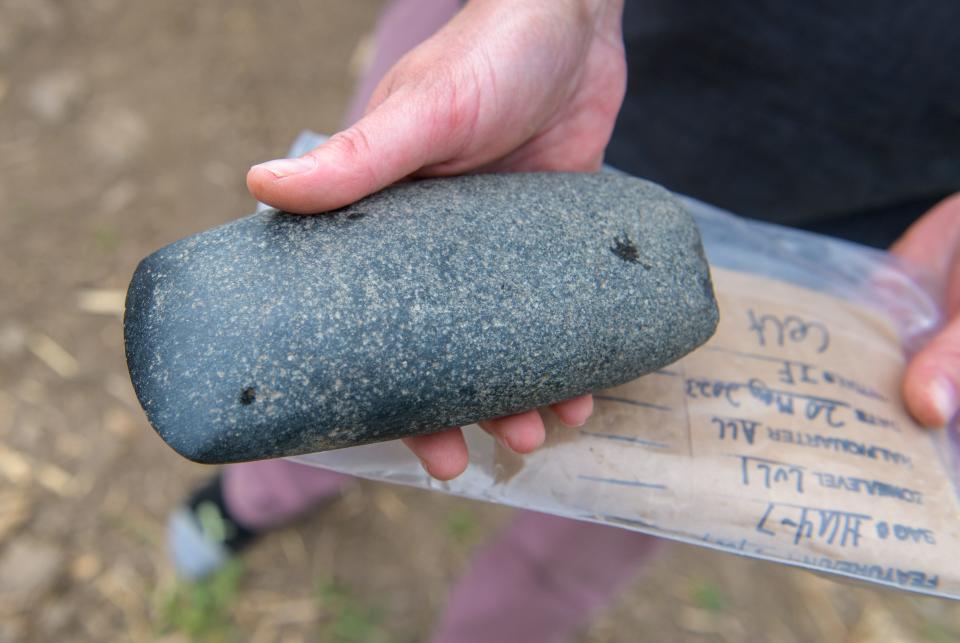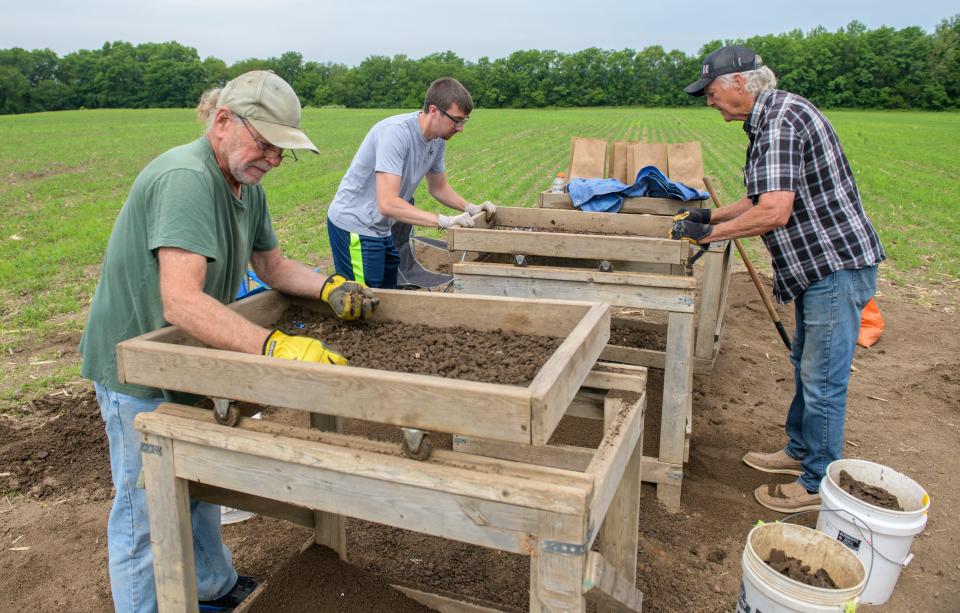'Slow detective process': Archaeologists uncover Native American artifacts in East Peoria

PEORIA – Four weeks of painstaking labor went into the excavation of a 600-year-old Native American home in East Peoria this summer, but the more prolonged task won't begin until archaeologists return to their labs with the artifacts they discovered.
“Usually a month in the field is at least a year in the lab,” said Dana Bardolph, an archaeologist based at Northern Illinois University. She and Greg Wilson, a professor of anthropology at the University of California, Santa Barbara, have been working since mid-May at a site near the McClugage Bridge. The artifacts they found will be cataloged, tested, and analyzed in the coming months.
“Archaeology is a slow detective process,” said Wilson. “We have pottery, we have stone tools, we have burnt plant remains and animal bones that will take slow analysis. We’ll be able to use that information to come up with important profiles of what people were eating, how they were living, where they were getting the raw materials, if they are hunting and fishing, and how all that compares or contrasts with earlier or later periods or different parts of Illinois or the Midwest. And for us, the question is: How did people cope in this period where there was intense warfare and a massive drought? How did people cope with those kinds of challenges?”
Animal bones and an ax
A drought is likely the reason the 600-year-old village was abandoned in the late 1300s or early 1400s. The house being excavated is among the last built on the site. It was one of many structures Bardolph and Wilson discovered when they mapped the area last winter with a magnetic gradiometer, a remote sensing device.
“They’re essentially really sensitive metal detectors,” said Wilson. “Any time somebody digs a hole in the ground or builds a stone wall or lights a fire, that’s going to have a different magnetic signature than an area that hasn’t been disturbed in any way. This instrument can detect really subtle differences in magnetic properties.”
Houses from that time period were built of wood and typically burned when abandoned. Burning leaves a distinct mark that helps archaeologists discern the parameters of the house.
The building contained many interesting things, including an elk mandible.
“There hasn’t been elk in this area since 1855, so that’s a really interesting window into ecology,” said Bardolph.
It also contained copper and stone tools, including an ax.
“It’s much like a metal ax with a sharpened bit. It’s made out of igneous rock, probably from a local glacial deposit in a creek,” said Wilson. “It’s quite sizable — it would have been used for heavy-duty woodwork, like chopping, and it would have been hefted in a wooden handle, kind of socketed into it, so you could chop with it. If you needed to, you could push it out of the handle and use it like a wedge. It also would have doubled as a weapon of war.”
Making an ax from a piece of found stone is a lot of work, so typically axes discovered in archeological digs are well used and show signs of repair. But the ax found at the East Peoria site looks brand new, said Wilson, and its size is surprising.

“Usually the ones we find in this region are pretty small," said Wilson. Large axes have been found farther south in the Native American settlement in Cahokia. In an earlier time period, Cahokia was likely a cultural center for people in the Peoria area.
“Cahokia had a major woodworking industry. They cleared lots of woods for agricultural fields, so they had really big axes, like industrial strength axes," said Wilson. “Up here they never had the demands, with the small settlements, so they never needed these large axes. They had smaller woodworking tools. But this is like the size of a Cahokia ax, so it’s kind of surprising to find.”
Why the ax was in the house is one of many mysteries the archaeologists hope to solve with their research.
More: Knoxville Avenue castles: 2 renowned Peoria homes have a lot in common. Here's the history
Collaborating to tell an untold story

The Native American village is not the only area spot to capture Bardolph's and Wilson's interest. They've also been working to pinpoint where the French colonial village was on the Peoria side of the Illinois River. Not a lot is known about the French occupation in the Peoria area, which began in 1673 when Father Jacques Marquette and fur trader Louis Joliet landed in Illinois.
“For most people, Illinois history begins with statehood, and often forgotten, in the Peoria area in particular, was 130 years of French colonial occupation. That’s a time period we are really interested in," said Bardolph. “Peoria was the first French military post in the Illinois country, but relatively little is known about it compared to some of the other French colonial occupations in Illinois.”
The pair have been using remote sensors on land near Detweiller Marina in an effort to pinpoint where the village was.
“By looking at French colonial archives and maps, we were able to overlay historic maps on the modern city streets of Peoria and locate high probability areas of where those French settlements were,” said Bardolph.
Because the French settlers intermarried extensively with native people, the project aligns with the interests of descendants of Native Americans who lived in the Peoria area, said Bardolph. She and Wilson have been consulting with representatives from several tribes associated with Peoria to find out what information would be relevant to them, and to ensure their archaeological methods align with Native American values. Bardolph and Wilson are leading a collaborative effort to uncover history that has been ignored for too long.
“We want to help tell the story of indigenous history in this region,” said Bardolph. “Native Americans have lived here for at least 600 generations, and that story needs to be told.”
More: A fixture from Peoria's Frank Lloyd Wright house sold for millions. When was it removed?
Leslie Renken can be reached at (309) 370-5087 or lrenken@pjstar.com. Follow her on Facebook.com/leslie.renken.
This article originally appeared on Journal Star: Archaeologists excavate Native American home in Tazewell County

 Yahoo Autos
Yahoo Autos 